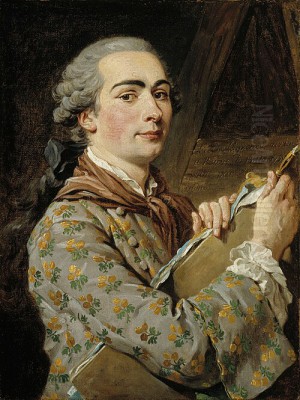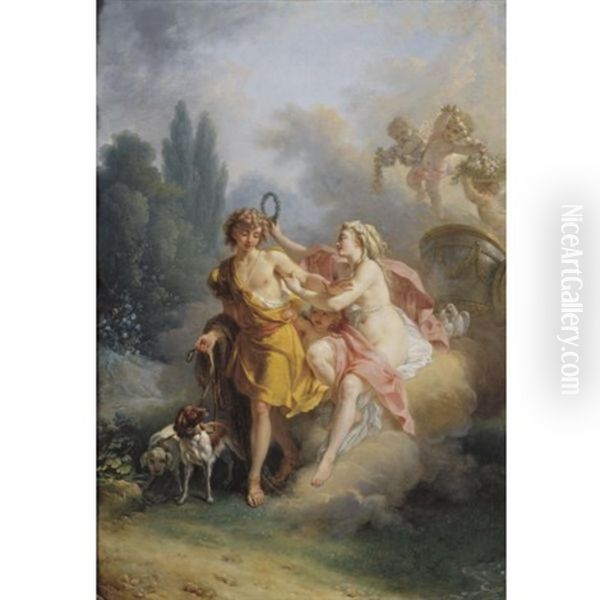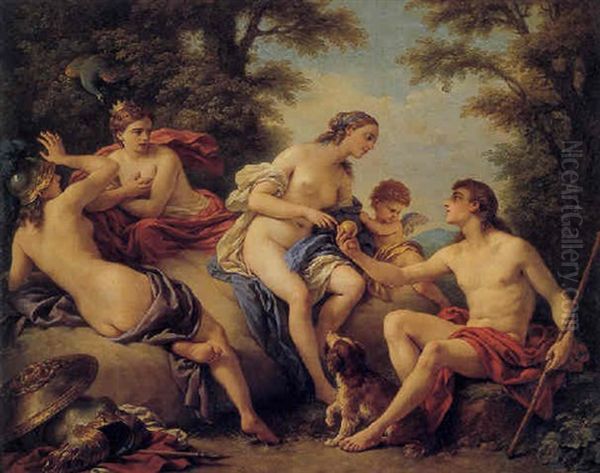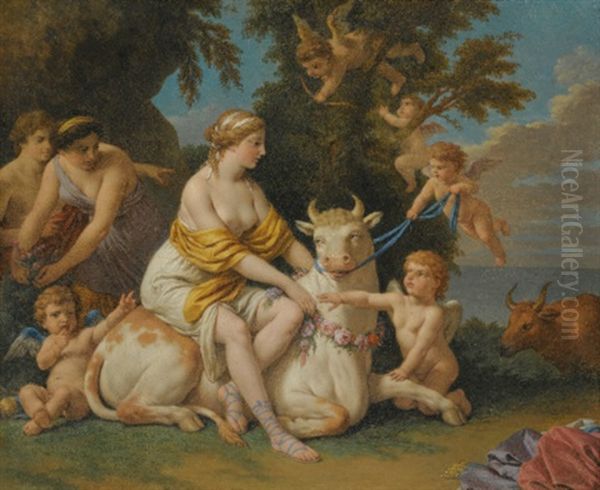Introduction: An Elegant Interpreter of Myth

Louis Jean François Lagrenée, often referred to as Lagrenée the Elder to distinguish him from his younger brother and fellow artist Jean-Jacques Lagrenée, stands as a significant figure in eighteenth-century French painting. Born in Paris on December 30, 1724, and passing away in the same city on June 19, 1805, his long life spanned a tumultuous period in French history, witnessing the height of the Rococo, the rise of Neoclassicism, the French Revolution, and the dawn of the Napoleonic era. Primarily known as a history painter, Lagrenée specialized in mythological and allegorical subjects, rendered in a refined and graceful style that perfectly captured the sensibilities of the late Rococo period, while subtly incorporating elements that foreshadowed the Neoclassical aesthetic. His technical skill, elegant compositions, and appealing subject matter earned him considerable acclaim during his lifetime, securing prestigious commissions and high academic positions.
Early Life and Artistic Formation
Lagrenée's artistic journey began in his native Paris, the vibrant heart of the European art world. Recognizing his talent, he was placed in the studio of Carle van Loo, one of the most prominent and versatile painters of the era. Van Loo, himself part of a dynasty of artists, was known for his mastery across various genres, including history painting, portraiture, and decorative schemes. Under Van Loo's tutelage, Lagrenée received a thorough grounding in the academic tradition, mastering drawing, composition, and the techniques of oil painting. This training emphasized clarity, skillful execution, and adherence to the classical principles that underpinned French academic art, even within the more decorative framework of the Rococo.

His talent blossomed under Van Loo, leading him to compete for the prestigious Prix de Rome, the ultimate prize for young French artists, which funded several years of study at the French Academy in Rome. Lagrenée won the Grand Prix in 1749, a testament to his already considerable abilities. This victory opened the doors to Italy, the essential destination for any aspiring history painter seeking direct exposure to the masterpieces of antiquity and the Renaissance. His time in Rome, typically lasting around four years, proved deeply influential, shaping his artistic direction and refining his style.
The Influence of Italy and the Bolognese Masters
During his stay in Rome, Lagrenée immersed himself in the study of classical sculpture and the works of the Italian masters. He was particularly drawn to the painters of the Bolognese School, which had flourished in the late sixteenth and seventeenth centuries. Artists like Guido Reni and Francesco Albani became significant touchstones for Lagrenée. He admired their classical compositions, idealized figures, graceful lines, and harmonious color palettes. The influence of Albani, known for his charming mythological scenes often featuring Venus, nymphs, and cupids set in idyllic landscapes, was particularly profound.
This affinity was so noticeable that Lagrenée eventually earned the flattering nickname "l'Albane français" (the French Albani). This comparison highlighted his ability to capture a similar spirit of lyrical classicism, adapting the elegance and charm of the Bolognese masters to the tastes of his own time. He absorbed their emphasis on grazia (grace) and idealized beauty, elements that would become hallmarks of his mature style. His Roman sojourn provided not just technical refinement but also a deep well of thematic and stylistic inspiration drawn directly from the Italian tradition, particularly the lineage tracing back through the Carracci family to Renaissance ideals.
Academic Success and Royal Patronage in Paris
Upon returning to Paris from Rome around 1754, Lagrenée quickly sought to establish his reputation. The primary route to success for an ambitious history painter was through the Académie Royale de Peinture et de Sculpture (Royal Academy of Painting and Sculpture). In 1755, he presented his morceau de réception (reception piece), The Abduction of Deianeira by the Centaur Nessus. This dynamic and skillfully executed painting, depicting a dramatic scene from Greek mythology, secured his admission into the Academy as a full member. The work, now housed in the Louvre Museum, demonstrated his mastery of anatomy, composition, and the expressive potential of mythological narrative, firmly establishing him within the academic hierarchy.

His acceptance into the Academy marked the beginning of a highly successful career. He became a regular exhibitor at the biennial Salons, the official art exhibitions that were crucial for visibility and patronage. His works, often featuring mythological lovers, graceful goddesses, and allegorical figures, appealed to the prevailing Rococo taste for elegance, charm, and sensuality, albeit tempered with a classical restraint learned in Italy. He quickly rose through the academic ranks, being appointed as an assistant professor and later a full professor, involved in the training of the next generation of artists. His success attracted the attention of the court and aristocracy, leading to important commissions, including works for royal residences like the Château de Bellevue, which belonged to Madame de Pompadour, Louis XV's influential mistress. One such work, Mars and Venus Surprised by Vulcan, decorated Bellevue, showcasing his ability to create sophisticated mythological scenes suitable for elite interiors.
Service to the Russian Empress
Lagrenée's reputation extended beyond the borders of France. In 1760, he accepted a prestigious invitation from Empress Elizabeth Petrovna of Russia to work at her court in St. Petersburg. This move reflected the widespread influence of French art and culture across Europe during the eighteenth century. In Russia, Lagrenée was appointed First Painter to the Empress and served as the Director of the Imperial Academy of Arts in St. Petersburg. This was a position of significant responsibility, involving not only the creation of works for the imperial court but also overseeing the development of artistic education in Russia along French academic lines.
His time in Russia, though relatively brief (he returned to Paris in 1762), was a mark of his international standing. He contributed to the Westernization of Russian art encouraged by the Empress, bringing his refined French style to the imperial court. While specific details of his output during this period are less documented than his French works, his role itself underscores the high esteem in which he was held. His departure was reportedly due to the harsh climate and perhaps a longing for the familiar artistic milieu of Paris. Upon his return, he seamlessly reintegrated into the Parisian art world, his status enhanced by his foreign service.
Mature Style: Rococo Grace and Neoclassical Hints
Lagrenée's mature style represents a sophisticated blend of late Rococo charm and an emerging Neoclassical sensibility. His paintings are characterized by their smooth finish, delicate modeling of forms, and harmonious, often pastel-inflected color palettes. Figures are typically idealized, possessing elegant proportions and graceful poses. He excelled in depicting tender or amorous mythological scenes, such as Diana and Endymion, where the goddess Diana gently approaches the sleeping shepherd, or Psyche Surprising the Sleeping Cupid, a work praised for its delicate intimacy and considered a quintessential example of Rococo sentiment.

While firmly rooted in the Rococo aesthetic championed by artists like François Boucher and Jean-Honoré Fragonard, Lagrenée's work often displays a greater sense of classical order and restraint than that of his more exuberant contemporaries. His compositions are generally clear and balanced, and his figures, while graceful, often possess a sculptural quality reminiscent of his Italian studies. This classicizing tendency became more pronounced in his later works, aligning him with the gradual shift towards Neoclassicism being promoted by figures like Joseph-Marie Vien, who would eventually succeed Lagrenée as Director of the French Academy in Rome. However, Lagrenée never fully embraced the severity and moralizing tone of high Neoclassicism, as exemplified by Jacques-Louis David, retaining a preference for grace and charm throughout his career.
Notable Works and Thematic Preferences
Lagrenée's oeuvre is dominated by mythological and allegorical subjects, drawn primarily from Greek and Roman antiquity. Works like The Abduction of Deianeira by the Centaur Nessus (1755), his Academy reception piece, showcase his ability to handle dramatic action and complex figural arrangements. Mars and Venus Surprised by Vulcan (c. 1755-1760), painted for Bellevue, exemplifies his skill in depicting intimate mythological narratives with elegance and psychological nuance. Diana and Endymion (various versions) captures the poetic tenderness he often brought to classical myths.
His painting Demeter (also known as Ceres) teaching Triptolemus the art of agriculture reflects his engagement with themes of civilization and divine benevolence, rendered with characteristic grace. Psyche Surprising the Sleeping Cupid (c. 1768) is another highlight, admired for its delicate handling of light and emotion. He also painted allegorical series, such as representations of the seasons or the arts, and occasionally biblical subjects, though mythology remained his preferred domain. His depictions often focused on goddesses like Venus, Diana, and Ceres, or mythological lovers, allowing him to explore themes of love, beauty, and nature within a classical framework that appealed to the educated tastes of his patrons. The work cited as Le Two Nymphs likely refers to a painting exploring sensual themes through the depiction of graceful female figures, a common motif in his art.
Diderot's Critique and Lagrenée's Scale
Lagrenée's work was frequently reviewed by the influential Enlightenment philosopher and art critic Denis Diderot in his famous Salon reviews. Diderot, a keen observer of the contemporary art scene, held complex views on Lagrenée. While acknowledging the artist's skill, grace, and pleasing style, Diderot often expressed reservations, particularly regarding Lagrenée's large-scale history paintings. He famously quipped that Lagrenée's talent seemed to diminish as the size of the canvas increased ("plus la toile est vaste et plus le talent de Lagrenée diminue").
Diderot felt that Lagrenée excelled in smaller, more intimate cabinet pictures, where his delicate touch, refined finish, and charming compositions were most effective. In these smaller works, often destined for private collectors rather than grand public display, Lagrenée's elegance and sensitivity shone. Diderot found his larger, more ambitious history paintings sometimes lacking in force, grandeur, or emotional depth compared to the works of past masters like Nicolas Poussin or contemporary rivals who were moving towards a more robust Neoclassicism. Despite these critiques, Diderot's writings confirm Lagrenée's significant presence at the Salons and the general appeal of his style, even if the critic personally preferred works with stronger moral or dramatic impact, such as those by Jean-Baptiste Greuze.
Leadership at the French Academy in Rome
One of the pinnacles of Lagrenée's career was his appointment as Director of the Académie de France à Rome (French Academy in Rome) in 1781. He held this prestigious post until 1787, succeeding Joseph-Marie Vien (though some sources suggest Vien followed him; Vien was director 1775-1781, Lagrenée 1781-1787, then François-Guillaume Ménageot). This position placed him at the head of the institution where he himself had studied decades earlier. As Director, he was responsible for overseeing the studies and welfare of the young French artists who had won the Prix de Rome, guiding their immersion in the art of antiquity and the Italian masters.
His directorship occurred during a period when Neoclassicism was solidifying its dominance, heavily influenced by the discoveries at Pompeii and Herculaneum and the theoretical writings of Johann Joachim Winckelmann. Lagrenée, while representing an older, more Rococo-inflected tradition, presided over the training of artists who would define the Neoclassical era. His leadership in Rome further cemented his status within the French artistic establishment. During his tenure, he would have interacted with numerous young talents and visiting artists, contributing to the vibrant artistic exchange between Rome and Paris. His own continued preference for grace and elegance likely offered a counterpoint to the increasing severity of the emerging Neoclassical mainstream.
Lagrenée and His Artistic Circle
Throughout his long career, Lagrenée operated within a rich network of artists, patrons, and critics. His primary teacher was Carle van Loo, a dominant figure in mid-century French art. His younger brother, Jean-Jacques Lagrenée ("the Younger"), was also a painter, often working in a similar style, sometimes collaborating or exhibiting alongside him. Jean-Jacques accompanied Louis Jean François to Rome in the 1760s (this seems to contradict the earlier statement about the 1750s study, perhaps referring to a later visit or his brother's independent travel).
As a prominent academician and Salon exhibitor, Lagrenée was a contemporary of the leading Rococo masters François Boucher and Jean-Honoré Fragonard, whose styles, while related, often displayed a more overt sensuality or painterly dynamism. He also worked alongside artists transitioning towards Neoclassicism, like Joseph-Marie Vien. His career overlapped with the rise of Jacques-Louis David, the standard-bearer of Neoclassicism, whose sterner, politically charged art represented a significant departure from Lagrenée's graceful style. Other contemporaries included genre painter Jean-Baptiste Greuze, the celebrated portraitist Élisabeth Vigée Le Brun, and landscape painter Hubert Robert, known for his picturesque views of Roman ruins. Lagrenée's influences, the Bolognese masters Guido Reni and Francesco Albani, connect him back to the classical tradition passed down from Annibale Carracci and Agostino Carracci. His position within the Academy and his role in Rome placed him at the crossroads of evolving artistic trends.
Later Years, Honours, and Legacy
Lagrenée continued to paint and remain active in the art world into his later years, adapting somewhat to changing tastes while retaining his core style. The French Revolution, which began in 1789, dramatically altered the artistic landscape, dismantling the old Academy system and shifting patronage. Despite the upheaval and the dominance of Neoclassicism under the Republic and later Napoleon, Lagrenée's reputation endured.
In 1804, towards the very end of his life, he received significant recognition from the new regime. Napoleon Bonaparte appointed him Chevalier de la Légion d'Honneur (Knight of the Legion of Honour), a prestigious award established by Napoleon himself. In the same year, he was made honorary curator or conservator of the Musée Napoléon, the newly reorganized national museum housed in the Louvre Palace. These honours acknowledged his long service to French art and his respected status as an elder statesman of the artistic community. He died the following year, in 1805, at the age of eighty.
Louis Jean François Lagrenée the Elder left a legacy as a master of the graceful, mythological, and allegorical painting that characterized the late Rococo period in France. While perhaps overshadowed in popular memory by the more exuberant Fragonard or the revolutionary David, he was highly esteemed in his own time for his technical polish, elegant compositions, and charming subject matter. His work provides a crucial link between the Rococo and Neoclassical styles, embodying a refined classicism infused with eighteenth-century grace. His paintings continue to be appreciated for their decorative appeal, skillful execution, and elegant interpretation of classical themes, holding a significant place in the history of French art. Interestingly, despite his long and public career, sources consulted indicate a lack of widely circulated personal anecdotes or colourful incidents, suggesting a life perhaps more focused on professional dedication than dramatic personal events.
Conclusion: An Enduring Elegance
Louis Jean François Lagrenée the Elder navigated the complex artistic currents of the eighteenth century with remarkable success. From his training under Carle van Loo to his leadership roles in Paris, St. Petersburg, and Rome, he consistently produced works characterized by elegance, refinement, and technical mastery. As the "French Albani," he skillfully adapted the grace of the Italian Baroque to the sensibilities of the French Rococo, specializing in mythological and allegorical scenes that delighted patrons and critics alike. While Diderot noted his strengths lay in smaller canvases, Lagrenée's overall contribution was significant, earning him high honours and a lasting place in the academic tradition. His art stands as a testament to the enduring appeal of classical themes rendered with Rococo charm, representing a distinct and important facet of French painting during a period of profound artistic and social change.